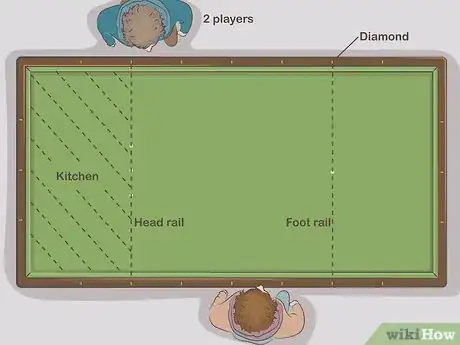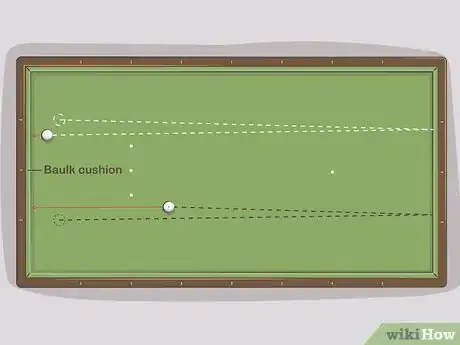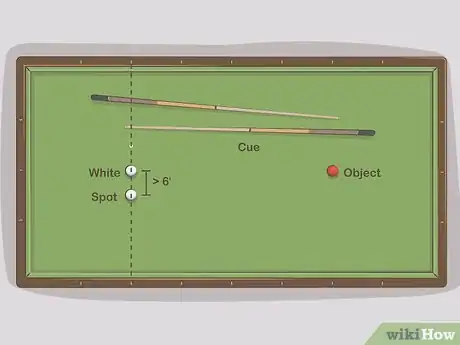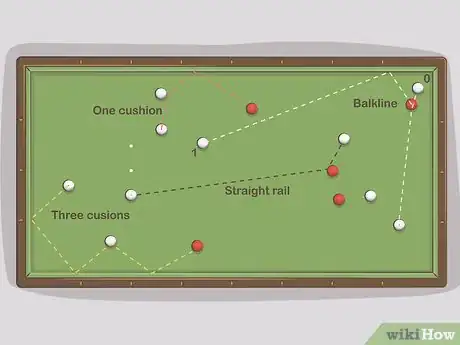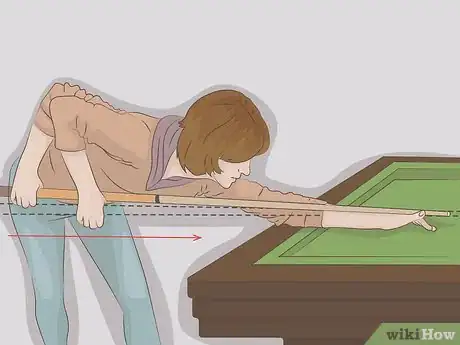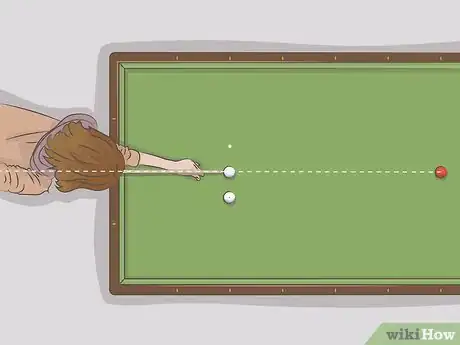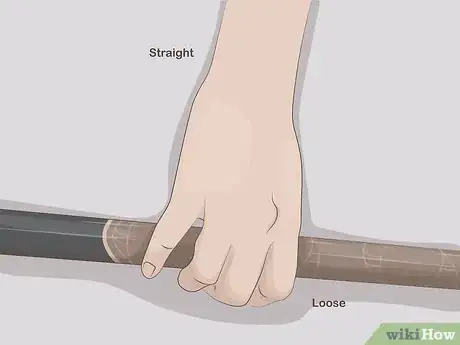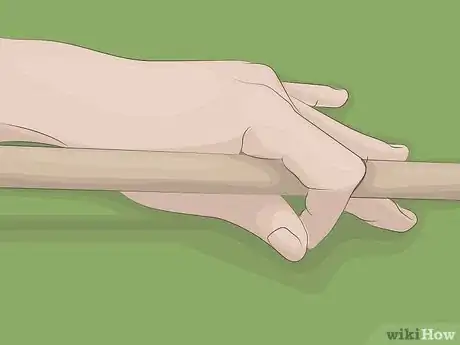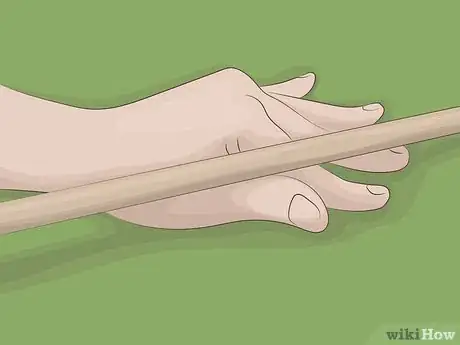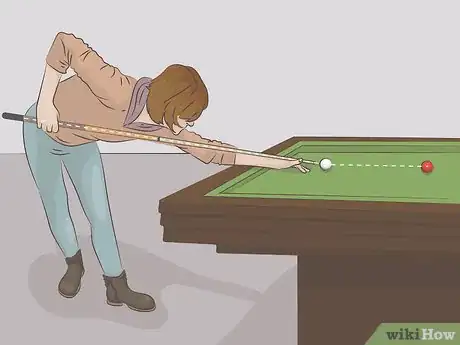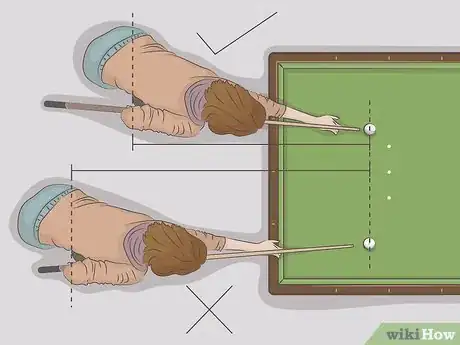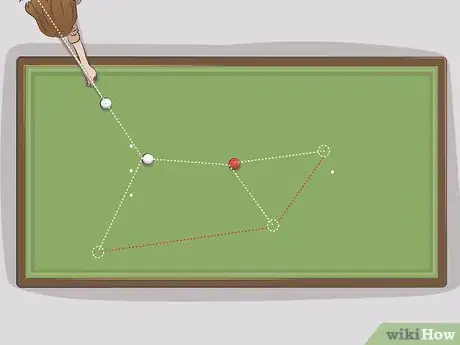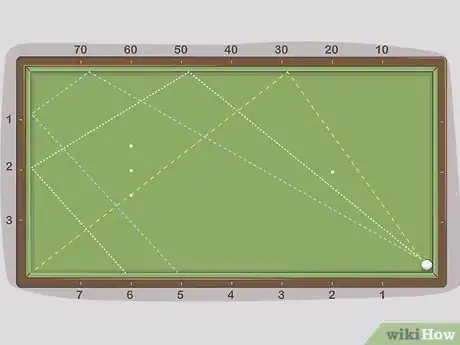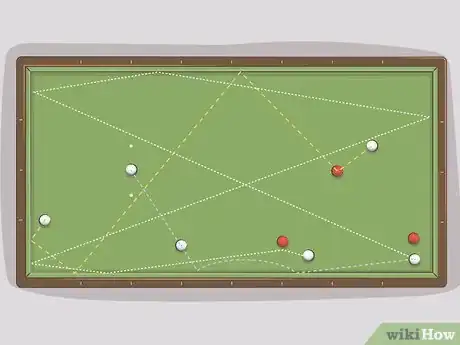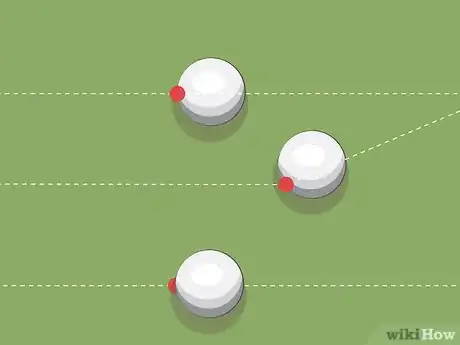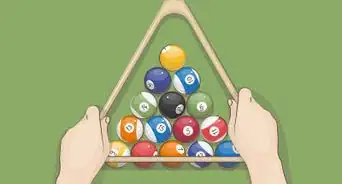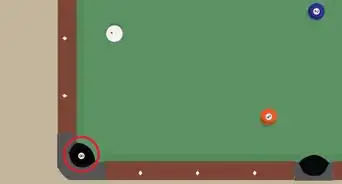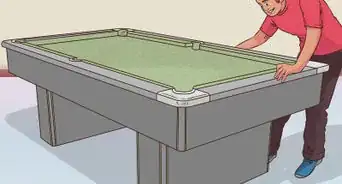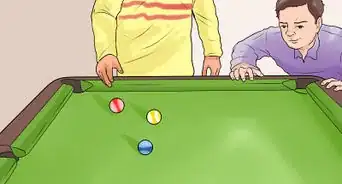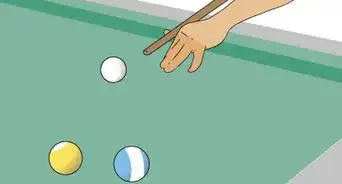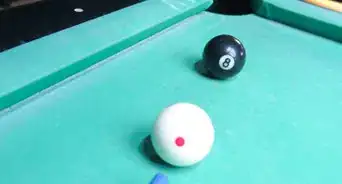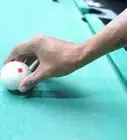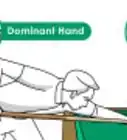wikiHow is a “wiki,” similar to Wikipedia, which means that many of our articles are co-written by multiple authors. To create this article, 17 people, some anonymous, worked to edit and improve it over time.
This article has been viewed 393,346 times.
Learn more...
Billiards games are divided into 2 types: carom billiards, played on a pocketless table in which the object is to bounce the cue ball off other balls or the table rails, and pocket billiards, played on a table with pockets in which the object is to sink the colored balls into the pockets by striking them with the cue ball -- aka pool.[1] If you're looking for pocket billiards, wikiHow has a great How to Play Pool article, too. But here, we'll cover the basics of carom billiards -- and its variations -- in addition to equipment and strategy. Carom billiards involves serious skill, often incorporating angles and trick shots. If you already know pool, carom is the next step!
Steps
Mastering the Rules
-
1Grab a partner and a billiards table. Carom billiards, of any variety, requires two people. It can be played with a third, but standard carom is with two. You'll need your standard billiards table -- 4 feet (1.2 m) by 8 feet (2.4 m), 4 1⁄2 feet (1.4 m) by 9 feet (2.7 m), 5 feet (1.5 m) by 10 feet (3.0 m), or 6 feet (1.8 m) by 12 feet (3.7 m) without pockets. This "without" pockets thing is pretty important. You could play on a pool table (pocket billiards), but you'll soon find that the pockets get in the way and could potentially ruin the game. Here's everything you need to know (and some things you may not) when it comes to the table:
- Those diamonds are for you to use! If you know your geometry, you can use them to aim your shot. We'll cover that in the next section (strategy).
- The rail by where the first player breaks is called the short, or head, rail. The opposite rail is called the foot rail, and the long rails are called the side rails.
- The area behind which you break, behind the "head string," is called the "kitchen."[2]
- The pros play on heated billiards tables. The heat gets the balls to roll more smoothly.
- It's green so you can look at it for long periods of time. Apparently humans can handle green better than any other color.
-
2Determine who goes first by "lagging." That's where you each line up your ball near the baulk cushion (the short end of the table where you break from), hit the ball, and see who can return it closest to the Baulk cushion as the ball slows to a stop. The game hasn't even started yet and it takes skill![3]
- If you hit the other player's ball, you forfeit your chance of calling who starts. If you do win the lag, it's generally accepted that you go second. The player who breaks generally wastes their turn setting up the balls, not taking a strategic shot.
Advertisement -
3Set up the game. You'll each need a cue stick, for starters (you had these for the lag, right?). Billiards cues are actually shorter and lighter than their pool counterparts, with a shorter ferrule (the white part near the end) and a thicker butt.[4] Then you'll need three balls -- one white cue ball (heretofore called "white"), one white cue ball with a black spot on it ("spot"), and one object ball, typically red. Sometimes a yellow ball is used in place of the spot.
- The person who wins the lag calls which ball they'd like to be theirs (cue ball), the white or the spot. It's just a matter of personal preference. The object ball (red) is then placed at the foot spot. That's where the point of the triangle would be in pool, by the way. The opponent's cue ball is placed at the head spot, where you normally break from in pool as well. The starting player's cue is then placed on the head string (in line with the head spot), at least 6 inches (15 cm) from their opponent's cue.
- So, obviously, when your ball is in line with your opponent's, it's very hard to hit both balls on the table. Hence why if you win the lag, you opt to go second.
- The person who wins the lag calls which ball they'd like to be theirs (cue ball), the white or the spot. It's just a matter of personal preference. The object ball (red) is then placed at the foot spot. That's where the point of the triangle would be in pool, by the way. The opponent's cue ball is placed at the head spot, where you normally break from in pool as well. The starting player's cue is then placed on the head string (in line with the head spot), at least 6 inches (15 cm) from their opponent's cue.
-
4Determine the rules you and your partner want to play by. As with any game that's centuries old, there are variations in play. Some make it easy, some make it hard, and some make it faster or slower. How much time do you have on your hands? And how much skill?
- For starters, every type of carom billiards involves getting a point by striking both balls on the table. It's how you do that that changes:
- In straight-rail billiards, as long as you hit both balls, you get a point. This is easiest.
- In one-cushion billiards, you must hit one cushion (one side of the table) before the second ball is displaced.
- In three-cushion billiards, you must hit three cushions before the balls roll to a stop.
- Balkline billiards removes the one flaw in this game. If you manage to get both balls into a corner, you could, presumably, hit them off of each other over and over and over. Balkline billiards stipulates that you cannot receive points from a shot where the balls are in the same area (often the table is divided into 8 sections) of the table.
- Once you determine how you get points, decide at what point you'd like to stop. In one-cushion, that number is generally 8. But three-cushion is so hard, you'll have better luck with 2!
- For starters, every type of carom billiards involves getting a point by striking both balls on the table. It's how you do that that changes:
-
5Play the game! Move your arm smoothly back, then forward in a pendulum motion. The rest of your body should remain still as you stroke through the cue ball, letting the cue come to rest naturally. There you have it -- all you gotta do is hit both balls to receive a point -- technically, each turn is referred to as a "cannon." But here are some more specifics:
- The player who goes first must hit the red ball (it'd be weird to hit the other, anyway)
- If you score a point, continue shooting
- Playing "slop" (accidentally getting a point) is generally regarded as illegal
- Always keep one foot on the floor at all times
- "Jumping" the ball is a foul, as is hitting a ball when it's still in motion
-
6Look for the place on the cue ball where the cue tip should connect. You can do this while taking your practice strokes. Line up your cue stick with where you would hit the ball if you could hit it directly. Then aim for that spot.
- Most often, you'll want to hit the cue ball squarely in the center. Sometimes, you may want to hit the ball to one side or another to impart sidespin, or "English," to it to make the ball travel to one side. Occasionally, you may want to hit the cue ball below center to cause it to climb over a ball you don't want to move and strike a ball you do want to move.
Mastering the Cue and Your Stance
-
1Grip the cue stick correctly. Your shooting hand should grip the butt of the cue stick in a loose, relaxed manner, with your thumb as a support and your index, middle, and ring fingers doing the gripping. Your wrist should point straight down to prevent it from moving sideways when you take your shot.
- Your shooting hand should generally grip the cue stick about 6 inches (15 cm) to the rear of the stick's balance point. If you're short, you may want to move your hand forward of this point; if you're tall, you may want to move it further back.
-
2Place the fingers of your off-hand around the tip to form a bridge. This prevents the cue stick from moving sideways when you shoot. There are 3 main grips: the closed, the open, and the rail bridge.
- In a closed bridge, you wrap your index fingers around the cue and use your other fingers to steady your hand. This allows for more control over the stick, particularly with a forceful forward stroke.
-
3In an open bridge, form a V-groove with your thumb and forefinger. The cue will slide through and you will use your other fingers to keep the cue from moving sideways. The open bridge is better for softer shots and is preferred by players who have trouble making a closed bridge. A variation of the open bridge, is the elevated bridge, in which you raise your hand to lift the cue over an obstructing ball when striking the cue.
- Use the rail bridge when the cue ball is too close to the rail for you to slip your hand behind it. Lay your cue stick over the rail and keep its tip steady with your off hand.
-
4Align your body with the shot. Line yourself up with the cue ball and the ball you want to hit. The foot corresponding to your shooting hand (right foot if you're right-handed, left foot if you're left-handed) should be touching this line at a 45-degree angle. Your other foot should be a comfortable distance away from it and forward of the foot matching your shooting hand.
-
5Stand a comfortable distance away. This depends on 3 things: your height, your reach, and the location of the cue ball. The further away the cue ball is from your side of the table, the longer you'll have to stretch.
- Most billiards games require you to keep at least 1 foot (0.3 m) on the floor when shooting. If you can't do so comfortably, you may either need to take a different shot or use a mechanical bridge to rest the tip of your cue stick in when you shoot.
-
6Position yourself vertically with the shot. Your chin should be rest slightly over the table so that you're sighting down the cue stick as close to horizontal as comfortable. If you're tall, you'll need to bend your forward knee or both knees to get into position. You'll also need to bend forward at the hips.
- Either the center of your head or your dominant eye should line up with the center of the cue stick without tilting. Some professional pool players do tilt their heads, however.
- Most pocket billiards players put their heads 1 to 6 inches (2.5 to 15 cm) above the cue stick, while snooker players have their heads touching or almost touching the cue. The closer you bring your head, the greater your accuracy, but at a loss of range for the back and forward stroke.
Experimenting with Strategy and Game Variations
-
1Look for your best shot. This depends all on where the balls lie on the table. In carom billiards games that allow it, you want to take shots that gather the balls together so you can score repeatedly by bouncing them off one another (in other words, not Balkline). Take a look at the angles and how it all lines up. Take into account the cushions, if you need to, too!
- Sometimes, your best shot isn't a scoring shot (offensive shot) but to shoot the cue ball to a place where your opponent has difficulty making a scoring shot (that is, a defensive shot).
- Take a few practice strokes if you need them. This will limber up your arm before the actual shot.
-
2Get to know the "diamond system." Yep, math. But once you get it down, it's fairly simple. Each diamond has a number. You take the number of the diamond the cue would hit initially (called the cue position) and then subtract the natural angle (the number of the diamond on the short rail). This leaves you with a number -- the number of the diamond you should be aiming for!
-
3Play "artistic billiards." Yep, it's a thing. This is where players aim to complete 76 set-up variations, all of various levels of difficulty. So when you've got the game down, set yourself (and your friend) up some trick shots. Who can complete the most difficult ones?
- If one-cushion billiards is doable, try moving to two. Three is near impossible, even for the pros! If you can handle two, you should start playing for money!
-
4Strike the cue ball in different ways. How the cue ball strikes another ball can determine the direction the other ball travels. This effect is called "throw" and can be caused either by the angle at which the cue ball strikes the other ball, how much English was imparted to the cue ball, or both. Billiards players who've practiced and studied the effects of their shots make use of this when they play pool.
- Take some time to experiment! The more you see how many options you have, the better you'll get and the more fun the game will be. Take your carom billiards skill and start playing pool, 9-ball, 8-ball or even Snooker!
Community Q&A
-
QuestionWhere do I position the cue ball after sinking the one ball off the break?
 Community AnswerIt sounds like you are playing 9 ball, but in either case (8 or 9 ball) you want the cue ball to stay in the middle of the table. Most think that a good break is based on "power". That is not necessarily the case. It's more about the speed of your stroke and the way the cue hits the cue ball. With a long, fast stroke, you want the cue to strike the cue ball just a little above center. If your break is good, the cue will should jump slightly (6-8 inches) into the air and come down pretty much in the center of the table while all the other balls are scattered.
Community AnswerIt sounds like you are playing 9 ball, but in either case (8 or 9 ball) you want the cue ball to stay in the middle of the table. Most think that a good break is based on "power". That is not necessarily the case. It's more about the speed of your stroke and the way the cue hits the cue ball. With a long, fast stroke, you want the cue to strike the cue ball just a little above center. If your break is good, the cue will should jump slightly (6-8 inches) into the air and come down pretty much in the center of the table while all the other balls are scattered. -
QuestionShould I look at the cue ball or the ball I want to shoot?
 Community AnswerAlways focus on both at the same time -- you should be in line with both of the balls to hit them straight on.
Community AnswerAlways focus on both at the same time -- you should be in line with both of the balls to hit them straight on. -
QuestionIf the cue ball goes in first then the 8 ball, do I lose?
 Community AnswerYes, you will lose because this is a foul, you scratch the cue ball and the 8 ball goes in the pocket, so the opponent wins the game.
Community AnswerYes, you will lose because this is a foul, you scratch the cue ball and the 8 ball goes in the pocket, so the opponent wins the game.
wikiHow Video: How to Play Billiards
References
About This Article
Billiards is a category of games played on a billiard table. There are all kinds of different ways to play, such as 8-ball, 9-ball, carom, bumper pool, and snooker, but every game involves holding a cue and hitting a cue ball to strike object balls. To set up for a shot, hold the bottom of the cue, called the butt, with your dominant hand. Place your nondominant hand (called your bridge hand) 2-4 inches (5-10 cm) below the ferrule, which is the white portion underneath the tip of the cue. Turn to face the table at a roughly 150-degree angle and spread your feet to be slightly longer than shoulder-length apart. Place your head over the cue, and line the top half of the cue (called a shaft) up with your dominant eye. Place the tip of the cue behind the cue ball and set up your bridge hand. There are two ways to set your bridge hand up: open and closed. For an open bridge, place your palm flat against the table with the cue between your thumb and index finger. Straighten your four fingers and raise them at an angle to raise the pads of your fingers and the top of your palm off of the table. Keep your thumb taut against the side of your index finger, and use the groove between the thumb and index finger to steady the cue. For a closed bridge, raise your thumb, touch its tip to your index finger, and curve your index finger next to your middle finger to make a round opening. Slide your cue through that opening and use it to stabilize your shot. To shoot, look at the cue ball to see where you want to hit it, and then line the cue up with the object ball you’re shooting at. While you take practice strokes, move your eyes back and forth between the object ball and the cue ball. Where you hit the cue ball will determine the spin, or English, that goes on the cue ball. Hitting the bottom half of the ball will create backspin, so the ball will “draw” back after it hits the object ball. Hitting the top will cause it to roll forward, and hitting the sides will impart spin. For most shots, hitting “center ball” is the best way to maintain control of the cue ball. When you execute your shot, the only part of your body that should be moving is your forearm. Treat your elbow like a hinge and keep your head as still as possible. In general, the harder you hit the cue ball, the more difficult it will be to sink the object ball. However, the softer you hit the cue ball, the more likely it will be for the cue ball to drift off-course as it rolls over specks of dust on the table. Aim to sink most shots at “pocket speed,” which is slightly more than the minimum amount of speed to sink a shot. Billiards is all about consistency and repetition, so keep practicing and use the same stroke every time you shoot to improve over time. Keep reading to learn about the 3 main ways to grip your cue stick!
